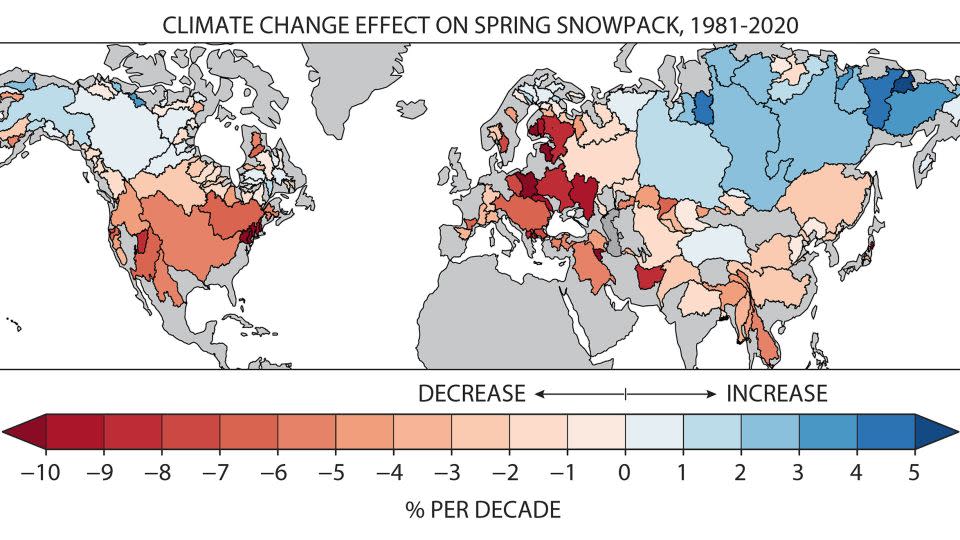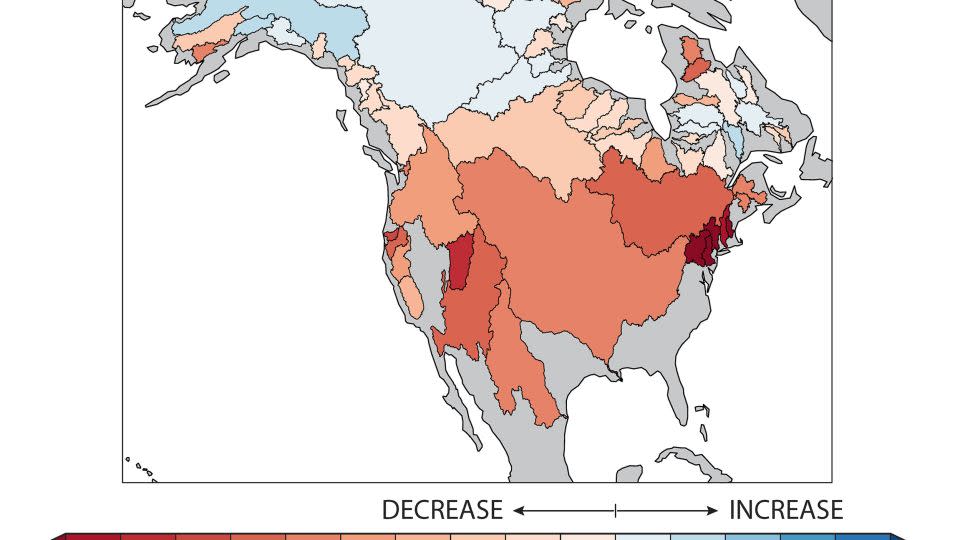Large parts of the US have been hit by powerful storms, including blizzards that have blanketed parts of the Midwest and Northeast in snow. But something is wrong: Many states accustomed to white winters are now getting more rain than snow.
A new study published Wednesday shows that the human-induced climate crisis has reduced snowpack in most parts of the Northern Hemisphere over the past four decades, endangering crucial water supplies for millions of people.
It may seem logical that a warmer world would be less hospitable to snow, but the relationship between snow and climate change is complex, and scientists have struggled for years to draw a clear connection between the two.
Part of the problem is that snowfall is notoriously difficult to measure accurately, and scientific data from ground observations, satellites and climate models have given conflicting signals about the role of climate change in declining snowpack. Some areas have even seen more snowfall in our warmer world.

But Wednesday’s study, published by Dartmouth College researchers in the journal Nature, offers the big picture: Climate change has caused significant snowfall declines in the world’s north since the 1980s. Areas in the southwestern and northeastern US, as well as central and eastern Europe, have experienced the steepest declines associated with global warming: between 10% and 20% per decade.
“It’s very clear that climate change is having negative impacts on snow and water,” said Alexander Gottlieb, lead author of the study and a doctoral candidate at Dartmouth College. “And every additional degree of warming will take away an increasing share of your snow water supplies.”
Less snow means less water supply
The researchers found that snowpack loss accelerates when the average winter temperature in a location rises above minus 8 degrees Celsius (about 17 degrees Fahrenheit), a point they call a “snow loss cliff.” Outside of that, snow loss accelerates even with modest temperature increases.
That’s a huge problem for communities that rely on snow for their water. Many of the world’s water resources are already threatened by climate change due to droughts and heat waves that are becoming more frequent and intense. As the planet continues to warm, the research shows that many densely populated areas that rely on snow will lose increasing amounts of water in the coming decades.
“If you have a regime that shifts to one that is no longer snow-dominated in winter, but instead rain-dominated, you have a situation where reservoirs can be half full or less,” said Justin Mankin, senior author of the book. study and associate professor of geography at Dartmouth, told CNN. “Then the question becomes: ‘Are we going to have a rainy spring?’” to offset water withdrawals from places downstream.
They also looked at watersheds to measure how much snowwater supplies had fallen. The study found a downward trend in snow cover in 82 of the Northern Hemisphere’s 169 major river basins, including the Colorado River in the US and the Danube in Europe, with 31 of them confidently showing the fingerprints of human-induced climate change .
“Most of the world’s people live in river basins that are on the edge of an ever-accelerating snow loss cliff, with each additional degree of warming meaning an ever-increasing loss of snowpack,” Mankin said.
To reach their conclusions, the researchers specifically analyzed declines in March snowpack between 1981 and 2020, because this provides a “useful summary of all winter weather,” Mankin said. He noted that the amount of snow on the ground in March indicates what winter conditions were like that season before spring melts the reservoir that seeps downstream to provide water for households and agriculture.
“The March snowpack is emblematic of everything that happened this past winter, and we are testing the sensitivity of that measure,” Mankin said.


Back-to-back years of less snow in the western U.S. have already provided a preview of what future winters and springs could look like in many parts of the Northern Hemisphere, from unprecedented water shortages to worsening wildfires, Mankin said.
Snow also helps prevent forest fires or can reduce their intensity. Unlike rain, which can run off quickly, snow melts slowly over time and can provide a slow and sustained release of water into the soil, making it less likely to ignite and providing less fuel for the spread of fires.
Less snow also takes a significant toll on places that rely on winter recreational activities, such as skiing and snowboarding, as major economic drivers. Many ski resorts in the Northern Hemisphere are already facing such challenges, and many are now relying on snowmaking to ensure there is enough snow to keep businesses operational. In some places, temperature thresholds are approaching that would make even machine-made snow unattainable.
Mona Hemmati, a postdoctoral researcher at Columbia Climate School who was not involved in the study, said the study provided “compelling evidence” of how human-induced climate change is affecting snow patterns.
“What makes this study groundbreaking is its approach to isolating the effects of anthropogenic climate change from natural climate variability,” Hemmati told CNN. “This study serves as a crucial reminder of the escalating impacts of climate change and the need for immediate and coordinated action to address this global challenge.”
For more CNN news and newsletters, create an account at CNN.com